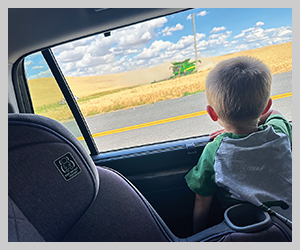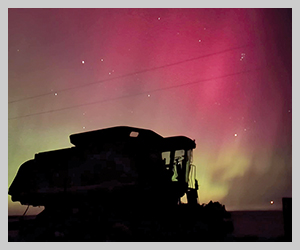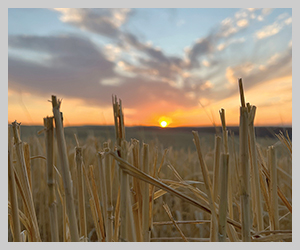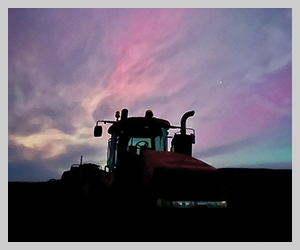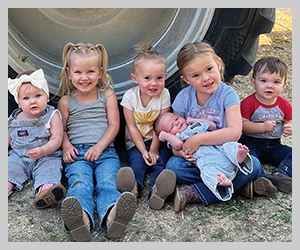Grant program gets green light Sustainable Farms and Fields will use $2 million to help fund climate-smart farming practices
2022April 2022
By Trista Crossley
Editor

After three years of stop-and-go progress, the Sustainable Farms and Fields (SFF) grant program finally has the green light to start funding climate-smart farming practices across Washington state.
“Sustainable Farms and Fields is a brand new program we are rolling out. It is intended to support growers who are interested in increasing climate-smart practices on their farms, where they can get technical and financial assistance through their local conservation districts or other public entities to help implement those practices,” said Alison Halpern, scientific policy advisor at the Washington State Conservation Commission (SCC) who has been working to develop the program. SFF, which will be managed by the SCC, received $2 million in the state’s 2022 supplemental budget. Halpern anticipates the program rolling out to producers in July of this year.
The general intent of SFF is to reduce greenhouse gas emissions and increase carbon sequestration on agricultural land, rangeland and tidelands. Since 2019, Halpern has been developing draft guidelines for the SFF with the help of the Washington State Department of Agriculture (WSDA), Washington State University (WSU) and the Natural Resources Conservation Service (NRCS). Initially, the practices that will be eligible for SFF funds will be drawn from NRCS’s list of approved, climate-smart best management practices. Those practices may include conservation cover for pollinators; conservation crop rotations that improve soil health; residue management through no-till and reduced till practices; cover crops; riparian buffers; nutrient management; prescribed grazing that improves wildlife habitat; and tree and/or shrub establishment that increases carbon sequestration. As the program develops, Halpern said additional practices that aren’t part of NRCS’s list may be added.
Producers won’t be able to apply for the funding directly; they’ll need to work through a public entity, most likely a conservation district, although WSU Extension, counties and municipalities will also be able to apply for funding for some of their eligible programs. Initially, Halpern anticipates much of the funding will go towards technical and financial assistance on the ground and cost sharing through the conservation districts.
“I think right now, the conservation districts are well poised to do that cost sharing, so they will be the leaders in providing financial assistance. But as far as technical assistance, I see us having multiple partners to do that along with the conservation districts,” she explained
One of the requirements is that the SFF funds are to be used throughout the state as fairly as possible and to support as many commodities as possible. In that light, $2 million isn’t very much to spread across an industry that grows more than 300 crops commercially and whose production totaled more than $9 billion in 2019. Halpern acknowledged that fact, but said they wanted to start small in anticipation of “bumps in the road.” The SCC will also be applying for the U.S. Department of Agriculture’s (USDA) Partnership for Climate-Smart Commodities, which has $1 billion of available funding for pilot programs that support climate-smart practices, create market opportunities for products that use climate-smart practices and develop ways to measure and verify greenhouse gas benefits. Although there is no match required for the USDA program, the fact that the state already has funds committed to climate-smart practices is a point in the state’s favor. Halpern also anticipates submitting a state budget package for SFF funding next year.
“The program does allow cost sharing for new equipment, and knowing how much a direct seed drill in Eastern Washington costs, that’s not going to do much. But if we start by doing the technical assistance and create some cost sharing while we are applying for additional funds, the program has room to grow. I think $2 million is just the starting point,” she said.
From no to go
The road to $2 million wasn’t easy. The original bill, SB 5947, sponsored by Sen. John McCoy (D-Tulalip), and co-sponsored by, among others, Sen. Mark Schoesler (R-Ritzville), was introduced in the 2019 Legislative Session a week before the cutoff deadline without much outreach to stakeholders or the state agencies included in the bill. Despite the concerns with the bill, there was enough interest that, although it didn’t pass that year, the Legislature provided proviso funding for the SCC and the WSDA to work with stakeholders to develop recommendations on what a good sustainable farms and fields program would look like. The SCC handed the reins to Halpern at that point.
One of the first things Halpern did was hold in-person stakeholder meetings and send out an online survey so producers could directly weigh in (see sidebar).
“What we learned from that survey is that the majority of producers were already implementing some climate-smart practices,” Halpern said. “They identified the lack of technical assistance and financial assistance as the two big barriers to doing more, but they were really interested in having an incentive program to help them increase these practices.”
Using that feedback, the bill was reintroduced with new language in the 2020 Legislative Session. The bill passed the Senate and the House and made it through the reconciliation process with strong bipartisan support. But then, like the rest of the world, it ran headfirst into COVID-19. In March 2020, the bill passed the Legislature, but because of economic uncertainties raised by the pandemic, no funding was attached to it. The program remained unfunded until the 2022 Legislative Session, although Halpern and her partners at WSDA, WSU and NRCS continued to work on developing guidelines.
Size doesn’t matter
One of the requirements of the bill is that funding is to be distributed across different-sized farms, and Halpern feels smaller-scale farms could really benefit from the results of implementing climate-smart practices. Those benefits could include improved soil health, increased drought resilience, flooding resiliency and, especially, reduced operating costs that come from using less water, fewer chemicals and less fuel (if no-till or reduced-tillage practices and precision agriculture are put in place).
“There is so much interest right now in carbon markets, but one of the concerns is that if you are a small farm and you implement all the climate-smart practices, you aren’t going to be as competitive or as profitable going into a carbon market if it’s calculated per acre,” she explained. “There are all of these economic co-benefits to these practices, and so we recognize that if we are providing technical assistance and financial assistance to smaller farms or to first time producers or historically underserved communities, including veterans, we have an opportunity to really help more farmers in Washington state be economically viable. For me, that’s one of the most exciting things about this program; it does help to mitigate against some of the effects of climate, but it also is intended to support farmers.”
Halpern has repeatedly heard from farmers frustrated that these types of programs bypass producers who have already implemented climate-smart practices. Because there’s no baseline requirement in SFF, she is confident that those farmers will still find something in the program for them, from technical assistance and cost-share opportunities to the economic co-benefits having healthier soil can bring.
“There are so many co-benefits that a wheat producer could benefit from even if they are doing one of the big practices like no-till. Nobody wants to be left out, and we don’t want to punish somebody for implementing climate-smart practices decades ago,” she said.
One of the concerns that was voiced back in 2019 and 2020 was that SFF would take money away from other state conservation programs, like the Voluntary Stewardship Program (VSP). Halpern is confident that rather than taking away from VSP, SFF can actually support it, especially in light of the fact that the SCC is looking at different funding sources. Halpern said SFF is different in its intent and structure from VSP, and farmers who get individual stewardship plans with recommendations that include climate-smart practices to meet VSP goals could conceivably get SFF funding to help with implementation.
For more information on SFF, visit scc.wa.gov/sff. In addition, Halpern is available by email at ahalpern@scc.wa.gov to answer questions.
“I love this program. I’m a plant ecologist, and I’m supposed to be focusing on the SCC’s science-based policy, but I feel so committed to this program because of the way it’s built, and I want to ensure its success. We had so much buy-in from farmers, and it’s so flexible and scalable,” she said.
Producer survey says…
Back in November of 2019, Alison Halpern, scientific policy advisor at the Washington State Conservation Commission (SCC), asked Washington state producers to fill out a simple survey to help the SCC build guidelines for the Sustainable Farms and Fields (SFF) program. Within the first nine days, 125 people had responded. In the end, she heard from 270 people, most of them actively engaged in agriculture. Some of the results included:
- More than 65 percent said they were currently implementing practices to reduce greenhouse gas emissions or sequester carbon.
- The top three barriers to adopting or implementing additional carbon-farming or emissions-reducing practices were questions over which options were best for one’s farm, the cost to upgrade equipment and unfamiliarity with the latest technology.
- Producers said cover crops, soil health, mulching/compost application and tree/shrub establishment should be the priorities for the SFF.
- More than 60 percent of survey respondents said they would be very likely to start adopting or implementing additional carbon-farming practices or emissions-reducing measures if there was financial or technical assistance.




